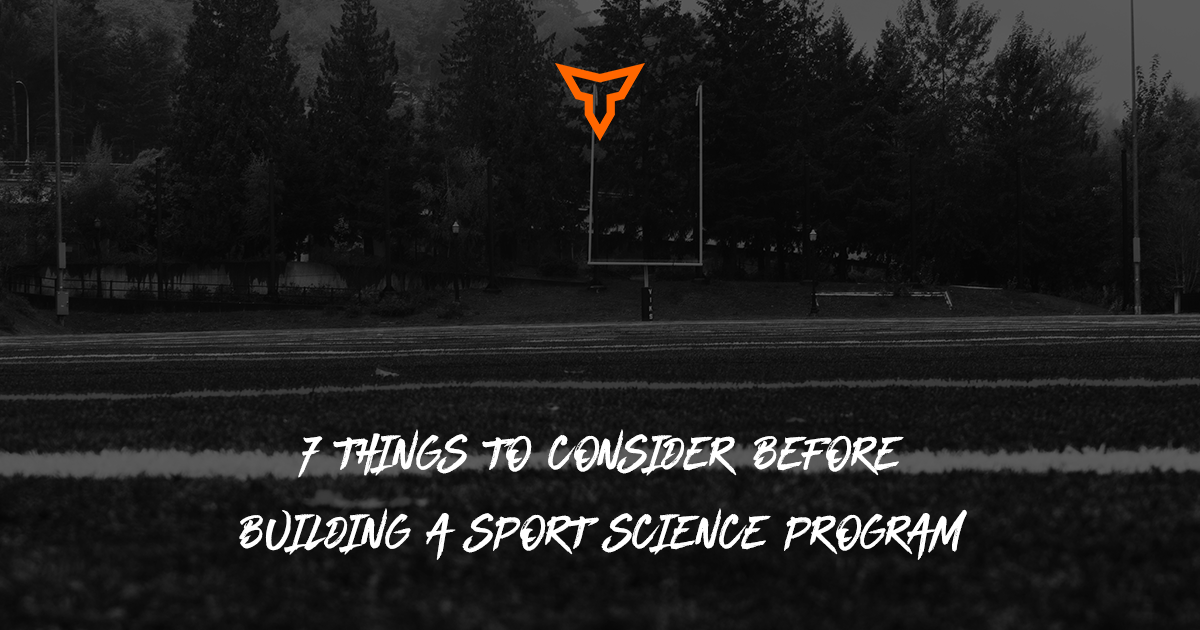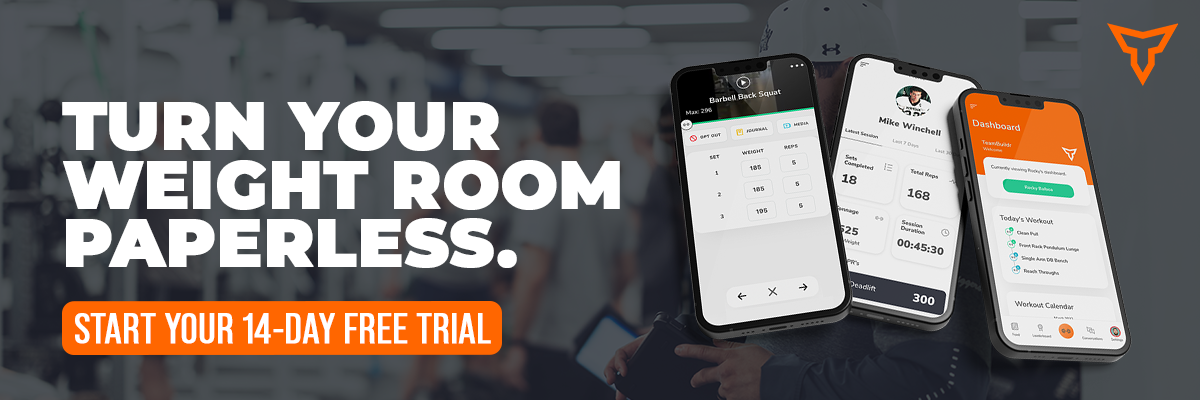Creating Flow: 5 Tips for Smoother Team Workouts
Whether you have access to a multi-level facility or a smaller sized space, how we manage flow during a team session is a crucial component of optimizing performance. The plan written on paper (or programmed on Teambuildr) is only as successful as its execution on the floor; a big part of our job stems from managing the athletes as they conduct themselves on the floor.
When I discuss “flow”, I’m talking about how the session will be conducted from start to finish. From the minute athletes walk in to the minute they walk out, we must account for the whole session. Sometimes, the obvious progressions of a session are overlooked; assumptions become a crack in the foundation of the flow during a lift. We need to communicate what we may feel to be common sense and plan our sessions with appropriate constraints to better guide and progress our athletes effectively to maximize both time and space.
Coaching session flow doesn’t seem to get as much attention as I feel it may deserve; we tend to get caught up in the prescriptions we put together and often neglect how to best conduct the session. Our staff program for multiple teams of different age groups and sports on a regular basis; team sessions often overlap and can lead to chaos or delays if flow isn’t managed.
Trust me, my staff and I have had those “oh s****” moments on multiple occasions; what we’ve planned on paper didn’t line up to be practical when put into action. Issues like floor space, equipment transitions and timing are just a few hurdles we’ve learned to overcome. The tips below are from our own experiences managing chaos to ensure sessions are optimized for our groups.
1. Communicate Expectations
This may seem obvious, but start the groups off on the right foot. Sometimes, we don’t have the luxury of having a set orientation type session; baptism by fire is usually how the first day goes. But, you can still plan to communicate the details clearly to build autonomy and a rhythm for athletes so they know what to do moving forward.
Before we actually start the session, we usually do a quick briefing. If it’s a team's first time with us, we use this opportunity to lay out all the expectations and pinpoint key aspects that will better help keep things running smoothly. Points include:
- The EXACT start time
- Where to put personal belongings
- Where to find their program cards
- Where to stretch or “chill” if early
- Where to meet when starting
- How to form groups
- How to adjust if group members are absent
- How to LISTEN to coach feedback and demonstrations
- How to RESPOND professionally to coach feedback
- How to read the program card
- Location of equipment
- Weight room etiquette
- The EXACT end time
- Where to meet for team debrief
- How to put reset the room
- How to file their programs upon exit
As you can see, we try to cover a lot of basic information. However, being transparent from the beginning can only make it easier to manage session flow later on. I guarantee you’ll have to repeat some of these points on multiple occasions, there isn’t any doubt in my mind that this will happen. However, we pride ourselves on running a “well-oiled machine” and as such, we need athletes to be autonomous and unanimous in their execution of the details in order for this to happen.
Setting the tone from the get-go is imperative; we can’t blame athletes or become frustrated if we didn’t make the time to communicate and uphold expectations early. Take the time to be transparent with your teams and be as detailed with your communication as you feel needed in order to build some rhythm and independence. Making assumptions will lead to headaches.
2. Pre-Set Workstations & Lanes
This seems rather obvious, but if you have the extra time, set up as many workstations as possible. Whatever the plan for the session is, assume a full roster of athletes have as many exercise series accounted for within the stations. This setup will vary depending on the equipment (more on utilizing different tools later).
We try to keep all equipment needed within the lane/area for the workout. Having full power racks, we try to utilize full space for different exercise series. It makes it easier to transition from A Series to B Series and so forth. What we are trying to avoid is having athletes crossover the room or migrate to different areas of the weight room. Especially during more intense sets; we don't want athletes getting distracted or putting themselves in an unsafe position.
For sprint work or exercises that require some floor space, we’ll set lanes on the turf that are designated to complete the task. Since these exercises are typically short bursts, we simply tell athletes to wait in line before completing the exercise.
The graphic below (Figure 1) illustrates a sample layout for an A Series in a training program. Athletes stay in their respective work lanes in order to complete the series. Equipment is laid out to ensure minimal crossover and operational flow.
3. Utilize Exercise Pairings
While I am a firm believer in purposeful rest for exercises that require higher outputs, I also understand that athletes can get bored and feel stagnant waiting around. In order to keep athletes engaged and prevent the odd wanderer, we utilize supersets, giant sets and other pairings to manage the flow of the room.
I truly believe we can accomplish both, sufficient rest and engagement. It just takes a little planning and communication. We try to create exercise series around groups of 4 athletes. Within the series, we’ll have a main focus lift and sprinkle in supplementary work that DOES NOT take away from the primary exercise. Some sample pairings may be as follows:
- Upper/Lower Series
- A1) Squat
- A2) Pull/Row
- A3) Trunk (Anti-Rotation)
- Contrast Series
- A1) Squat
- A2) Jump
- A3) Rotator Cuff
- Timed Series
- Repeat Jumps (5-10 Seconds)
- Trunk (Plank 5-10 Seconds)
- Rotator Cuff (Band Pull Apart 5-10 Seconds)
Feel free to get creative, just keep in mind basic principles. So long as the supplementary pairings don’t take away or hinder the main focus, I see no harm in putting additional exercises in. Be wary of pairing unilateral exercises with bilateral exercises. The time it takes to complete a set of unilateral exercises is longer compared to bilateral; this can cause a backup in flow with all athletes in a group waiting to complete the next exercise. Either pair unilateral exercises together or up the volume dosage of the bilateral pairings to compensate for the time.
In terms of flow, all exercises should aim to be done within the laid out work lanes. While we may have a handful of exercises we wish to focus on, we should still consider the space in which it needs to be done AND the time it may take to set up/execute the exercise. If the selections require an athlete to go across the room or takes them extended time to set up before initiating, it may not be worth it. The sample graphic below (Figure 2) shows a contrast series to optimize flow.
4. Pick Appropriate Tools
Building on our exercise series selections, the equipment needed to perform the exercise needs to be considered. It may seem like common sense, but having multiple barbell exercises in a single series may have you running into issues. For example:
- A1) BB Front Squat
- A2) BB Bent Row
- A3) Plate OH Carry
While there isn’t anything “wrong” with this series, it may be hard to execute in a group setting. If every rack has a single barbell, you become limited to accessibility. It should be noted that every exercise in this example also requires plates, another limitation if dealing with a group. A simple change of tools can resolve all limitations. For example:
- A1) BB Front Squat
- A2) DB Bent Row
- A3) KB Front Rack Carry
What we try to do (if possible) is have every exercise in a series use a different tool to manage flow. Whether it be barbells, dumbbells, kettlebells, bands or boxes, using different tools can ensure accessibility for most groups. Knowing that most athletes will likely require the same weights for some exercises, we want to make sure that we do our best to plan for this sort of issue. A sample tool format could be as follows:
- A1) Barbell Exercise
- A2) Dumbbell Exercise
- A3) Band/Bodyweight Exercise
There is a ton of freedom here depending on the type of equipment you have or decide to utilize. If stuck for ideas, the examples above can help. If you have PowerBlock dumbbells and/or full structure racks, get creative and maximize the space you have.
If you are limited with the equipment you have access to, don’t panic, there are options in your coaching toolbox. Even if your facility only has a few barbells, plates or dumbbells available for use, there is still a way to manage flow AND get quality work done. Here are a few tips to work around equipment limitations:
- Pick Unilateral Exercises
- Requires less weight to complete (plates, dumbbells, etc.)
- Single DB Work
- Can do contralateral or ipsilateral loading
- Tempos
- Requires less weight to complete (plates, dumbbells, etc.)
- Can do bilateral or unilateral loading
At our facility here at Iron performance Center, we have a plethora of attachments and equipment that we can take advantage of. The graphic below (Figure 3) illustrates how we can create an exercise series that revolves primarily around full rack usage while incorporating multiple pieces of equipment to manage flow.
5. Grouping Athletes
Another simple trick to making sure timing in the weight room is optimal is grouping athletes appropriately for the work to come. I wrote an article on specific ways for grouping athletes, so feel free to reference that for a detailed breakdown. A quick list of potential group options:
- Anthropometrics
- Training Age
- Relative Strength Level
- Position
In short, we’ll typically group athletes based on height and/or approximate strength level. This can help shave off valuable time of having to adjust bars or weights to accommodate the individual athlete within the group. It also prevents having athletes look to hop in with other groups to speed things along. The other grouping strategies can also work, choice is yours.
In Closing
Being able to manage the weight room floor is a crucial aspect of our roles to improve athletic performance. Knowing our limitations to be time and space, it is imperative we consider these aspects when planning and implementing our training programs. If nothing else, it can alleviate a lot of chaos and make the session environment more fun and productive for your athletes.
Subscribe to our blog
Subscribe to receive the latest blog posts to your inbox every week.
Related posts

How The NFL Combine Should Change (as told by a strength coach)

7 Things to Consider Before Building a Sport Science Program


